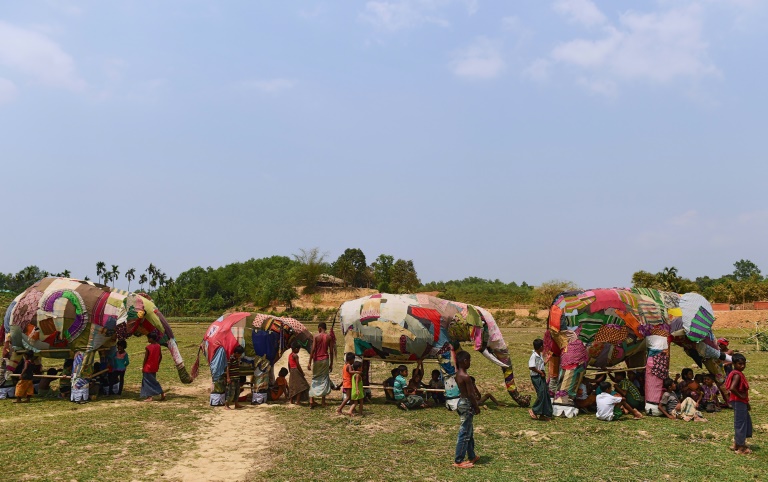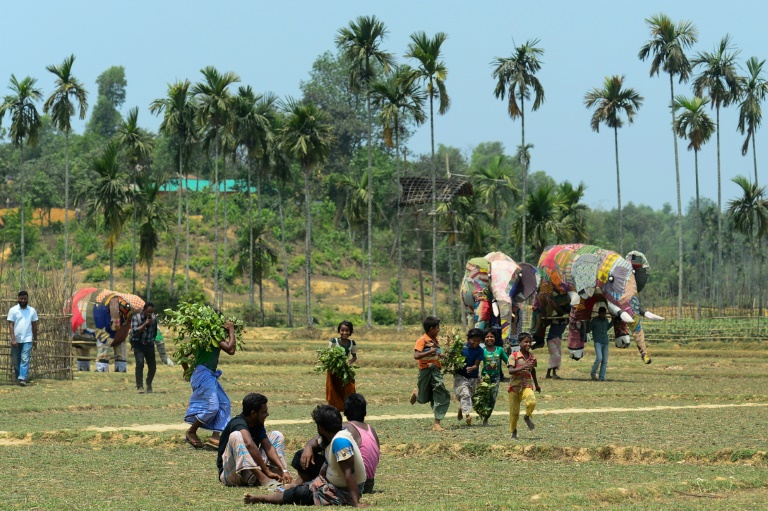Smiles and slapstick as Rohingya refugees learn to corral elephants

Part awareness raising, part pantomime, the scenario uses life-size puppets of elephants made from bamboo and old clothing and expertly propelled by volunteers. Photo: AFP
(AFP) - A trumpet fills the air as two "elephants" charge, scattering Rohingya refugee actors at a training session in a camp which cuts deep into Bangladeshi forest once reserved for the protected species.
Part awareness raising, part pantomime, the scenario uses life-size puppets of elephants made from bamboo and old clothing and expertly propelled by volunteers.
Each charge - and exaggerated counter by bands of Rohingya villagers - draws squeals of delight from the children crowded around a dusty paddy field.
But the purpose of the training day is sobering - a dozen Rohingya have been killed in the last year by wild elephants whose habitat has been consumed by Kutupalong refugee camp.

Training days are now being held to kindle harmony between the refugees and the estimated 35 to 45 elephants who are now their neighbours. Photo: AFP
With hundreds of thousands of new refugees driven over the border since last August by violence in Myanmar, the camp now seeps deeper into the forest.
Refugees are stripping trees for firewood and building settlements on the bare hillocks.
As a result, man and beast are increasingly coming into conflict.
Training days are now being held to kindle harmony between the refugees and the estimated 35 to 45 elephants who are now their neighbours.
"Elephants take the same migratory route, it’s in their genetic memory. Now more than 600,000 Rohingya are in the middle of that route," Raquibul Amin, country director for the International Union for Conservation of Nature (IUCN) told AFP on Saturday at Kutupalong camp.
"The aim is to demystify the elephant as an enemy... and to try to train people to deal with elephants when they encounter them," he said, of a training event held in conjunction with the UNHCR.
Rohingya volunteers show how to safely corral an elephant that strays into settled areas and use whistles and human chains to drive them away.
The mock-up elephants are covered by a ‘skin’ made from old clothing donated and stitched by Rohingya women - part of efforts to bond the new community with their older forest neighbour.
The drama plays out under a scorching sun, bringing a rare community event to people whose villages lie in ruins across the border.

"Elephants take the same migratory route, it is in their genetic memory. Now more than 600,000 Rohingya are in the middle of that route," Raquibul Amin, country director for the IUCN said. Photo: AFP
Delighted by the break in the humdrum camp life, children jump up and down in real elephant prints, hardened into the abandoned paddy.
Rina Aktar, 10, recalls her alarming encounter with a ‘Hati’ (elephant), her arms at full stretch to indicate its enormity.
"I was collecting firewood in the forest when I saw it... it was so big, I just ran away."
Her fears are valid.
The last death happened in late March when a bull elephant followed a path up a hillside crammed with Rohingya homes.
It adds to the tension and stress of a Muslim minority unwanted in Myanmar and forced from their homes by last year’s army campaign.
With repatriation for now appearing a pipe dream, Rohingya communities nearest the forest are preparing for more unwelcome run-ins with elephants.
But at least now some of the refugees are equipped to deal with them.
"I have handled elephants three times already since I have been here," said UNHCR elephant volunteer Nabi Hussein. "I didn’t panic."

